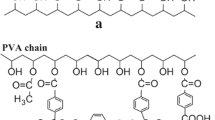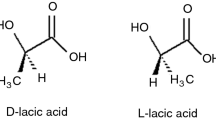Abstract
Poly (lactic acid) (PLA) has received considerable attention as a sustainable and biodegradable alternative to petroleum-based polymers in recent years. In general, the properties of PLA depend on its molecular chain structure, e.g., linear, branched, and aggregated structure, e.g., orthorhombic α-form and stereocomplex crystals. However, the evolution of hierarchical structure triggered by photo-oxidation degradation remain elusive for PLA. Herein, the accelerated photo-oxidation degradation behaviors of PLA samples with different thermal histories, including quenching (PLA-q), slow cooling (PLA-c), and annealing (PLA-a), were investigated by several characterization techniques. Compared to PLA-q and PLA-c, PLA-a exhibits relatively lower rates of molecular chain scission and oxygen-containing groups generation during the accelerated photo-oxidation process, suggesting that the increase in crystallinity contributes to suppressing the degradation of PLA. Changes in the molecular chain structure leads to the evolution of aggregation structure. The crystallinity of PLA samples, whether slowly cooled or annealed, increases with UV exposure time, which is attributed to the newly-formed crystals induced by chemi-crystallization. Unexpectedly, although PLA-a exhibits a slower photo-oxidation degradation rate than PLA-q and PLA-c, it undergoes embrittlement at an earlier stage. Morphological observations of photo-oxidized samples indicate that the degradation reaction of PLA-a occurs preferentially in the amorphous region, transforming the molecular chains into volatile products and eventually resulting in the embrittlement of PLA materials. This research sheds light on photo-oxidation degradation behaviors of PLA, and will serve as a valuable reference for investigating the degradation of other bio-based polymeric materials.








Similar content being viewed by others
References
Chen GQ, Patel MK (2012) Plastics derived from biological sources: present and future: a technical and environmental review. Chem Rev 112:2082–2099
Farah S, Anderson DG, Langer R (2016) Physical and mechanical properties of PLA, and their functions in widespread applications - a comprehensive review. Adv Drug Deliv Rev 107:367–392
Inkinen S, Hakkarainen M, Albertsson AC, Sodergard A (2011) From lactic acid to poly(lactic acid) (PLA): characterization and analysis of PLA and its precursors. Biomacromolecules 12:523–532
Haider TP, Volker C, Kramm J, Landfester K, Wurm FR (2019) Plastics of the future? The impact of biodegradable polymers on the Environment and on Society. Angew Chem Int Ed Engl 58:50–62
Lambert S, Wagner M (2017) Environmental performance of bio-based and biodegradable plastics: the road ahead. Chem Soc Rev 46:6855–6871
Lim LT, Auras R, Rubino M (2008) Processing technologies for poly(lactic acid). Prog Polym Sci 33:820–852
Jalali A, Romero-Diez S, Nofar M, Park CB (2021) Entirely environment-friendly polylactide composites with outstanding heat resistance and superior mechanical performance fabricated by spunbond technology: exploring the role of nanofibrillated stereocomplex polylactide crystals. Int J Biol Macromol 193:2210–2220
Freeland B, McCarthy E, Balakrishnan R, Fahy S, Boland A, Rochfort KD, Dabros M, Marti R, Kelleher SM, Gaughran J (2022) A review of Polylactic Acid as a replacement material for single-use Laboratory Components. Materials 15:2989
Jalali A, Huneault MA, Nofar M, Lee PC, Park CB (2019) Effect of branching on flow-induced crystallization of poly (lactic acid). Eur Polym J 119:410–420
Mehrabi Mazidi M, Edalat A, Berahman R, Hosseini FS (2018) Highly-toughened Polylactide- (PLA-) based Ternary blends with significantly enhanced Glass Transition and Melt Strength: tailoring the interfacial interactions, phase morphology, and performance. Macromolecules 51:4298–4314
Jalali A, Huneault MA, Elkoun S (2016) Effect of thermal history on nucleation and crystallization of poly(lactic acid). J Mater Sci 51:7768–7779
Nagarajan V, Mohanty AK, Misra M (2016) Perspective on Polylactic Acid (PLA) based sustainable materials for durable applications: Focus on Toughness and Heat Resistance. ACS Sustainable Chem Eng 4:2899–2916
González-López ME, Martín del Campo AS, Robledo-Ortíz JR, Arellano M, Pérez-Fonseca AA (2020) Accelerated weathering of poly(lactic acid) and its biocomposites: a review. Polym Degrad Stab 179:109290
Tripathi N, Misra M, Mohanty AK (2021) Durable polylactic acid (PLA)-based sustainable engineered blends and biocomposites: recent developments, challenges, and opportunities. ACS Eng Au 1:7–38
Atalay SE, Bezci B, Özdemir B, Göksu YA, Ghanbari A, Jalali A, Nofar M (2021) Thermal and environmentally Induced Degradation behaviors of Amorphous and Semicrystalline PLAs through Rheological Analysis. J Polym Environ 29:3412–3426
Zaaba NF, Jaafar M (2020) A review on degradation mechanisms of polylactic acid: Hydrolytic, photodegradative, microbial, and enzymatic degradation. Polym Eng Sci 60:2061–2075
Lila MK, Shukla K, Komal UK, Singh I (2019) Accelerated thermal ageing behaviour of bagasse fibers reinforced poly (lactic acid) based biocomposites. Compos Part B: Eng 156:121–127
Ndazi BS, Karlsson S (2011) Characterization of hydrolytic degradation of polylactic acid/rice hulls composites in water at different temperatures. Express Polym Lett 5:119–131
Copinet A, Bertrand C, Govindin S, Coma V, Couturier Y (2004) Effects of ultraviolet light (315 nm), temperature and relative humidity on the degradation of polylactic acid plastic films. Chemosphere 55:763–773
Jamshidi K, Hyon SH, Ikada Y (1988) Thermal characterization of polylactides. Polymer 29:2229–2234
Cam D, Marucci M (1997) Influence of residual monomers and metals on poly (l-lactide) thermal stability. Polymer 38:1879–1884
Zhou Q, Xanthos M (2008) Nanoclay and crystallinity effects on the hydrolytic degradation of polylactides. Polym Degrad Stab 93:1450–1459
Chávez-Montes W, González-Sánchez G, López-Martínez E, de Lira-Gómez P, Ballinas-Casarrubias L, Flores-Gallardo S (2015) Effect of Artificial Weathering on PLA/Nanocomposite Molecular Weight distribution. Polymers 7:760–776
Tsuji H, Sugiyama H, Sato Y (2012) Photodegradation of poly(lactic acid) stereocomplex by UV-Irradiation. J Polym Environ 20:706–712
Han W, Luo C, Yang Y, Ren J, Xuan H, Ge L (2018) Free-standing polylactic acid/chitosan/molybdenum disulfide films with controllable visible-light photodegradation. Colloid Surf A 558:488–494
Hardy C, Kociok-Kohn G, Buchard A (2022) UV degradation of poly(lactic acid) materials through copolymerisation with a sugar-derived cyclic xanthate. Chem Commun 58:5463–5466
Lv Y, Huang Y, Yang J, Kong M, Yang H, Zhao J, Li G (2015) Outdoor and accelerated laboratory weathering of polypropylene: a comparison and correlation study. Polym Degrad Stab 112:145–159
Pospíšil J, Pilař J, Billingham NC, Marek A, Horák Z, Nešpůrek S (2006) Factors affecting accelerated testing of polymer photostability. Polym Degrad Stab 91:417–422
Litauszki K, Kovács Z, Mészáros L, Kmetty Á (2019) Accelerated photodegradation of poly(lactic acid) with weathering test chamber and laser exposure – A comparative study. Polym Test 76:411–419
Wu H, Zhao Y, Dong X, Su L, Wang K, Wang D (2021) Probing into the microstructural evolution of isotactic polypropylene during photo-oxidation degradation. Polym Degrad Stab 183:109434
Zaidi L, Kaci M, Bruzaud S, Bourmaud A, Grohens Y (2010) Effect of natural weather on the structure and properties of polylactide/Cloisite 30B nanocomposites. Polym Degrad Stab 95:1751–1758
Gardette M, Thérias S, Gardette J-L, Murariu M, Dubois P (2011) Photooxidation of polylactide/calcium sulphate composites. Polym Degrad Stab 96:616–623
Bocchini S, Fukushima K, Blasio AD, Fina A, Frache A, Geobaldo F (2010) Polylactic acid and polylactic acid-based nanocomposite photooxidation. Biomacromolecules 11:2919–2926
Ikada E (1997) Photo- and bio-degradable polyesters. Photodegradation behaviors of aliphatic polyesters. J Photopolym Sci Technol 10:265–270
Liu Q, Liu S, Xia L, Hu P, Lv Y, Liu J, Chen Z, Huang Y, Li G (2019) Effect of annealing-induced microstructure on the photo-oxidative degradation behavior of isotactic polypropylene. Polym Degrad Stab 162:180–195
Jalali A, Huneault MA, Elkoun S (2017) Effect of molecular weight on the nucleation efficiency of poly(lactic acid) crystalline phases. J Polym Res 24
Wu H, Zhao Y, Su L, Wang K, Dong X, Wang D (2021) Markedly improved photo-oxidation stability of α form isotactic polypropylene with nodular morphology. Polym Degrad Stab 189:109595
Höhne GWH (2002) Another approach to the Gibbs–Thomson equation and the melting point of polymers and oligomers. Polymer 43:4689–4698
Rabello MS, White JR (1997) Crystallization and melting behaviour of photodegraded polypropylene — II. Re-crystallization of degraded molecules. Polymer 38:6389–6399
Gao T, Zhang ZM, Li L, Bao RY, Liu ZY, Xie BH, Yang MB, Yang W (2018) Tailoring crystalline morphology by high-efficiency nucleating Fiber: toward high-performance poly(l-lactide) biocomposites. ACS Appl Mater Interfaces 10:20044–20054
Fayolle B, Richaud E, Colin X, Verdu J (2008) Review: degradation-induced embrittlement in semi-crystalline polymers having their amorphous phase in rubbery state. J Mater Sci 43:6999–7012
Hsu Y-C, Weir MP, Truss RW, Garvey CJ, Nicholson TM, Halley PJ (2012) A fundamental study on photo-oxidative degradation of linear low density polyethylene films at embrittlement. Polymer 53:2385–2393
Croll SG (2022) Stress and embrittlement in organic coatings during general weathering exposure: a review. Prog Org Coat 172:107085
Bai H, Huang C, Xiu H, Zhang Q, Fu Q (2014) Enhancing mechanical performance of polylactide by tailoring crystal morphology and lamellae orientation with the aid of nucleating agent. Polymer 55:6924–6934
Acknowledgements
Financial supports from the Shandong Provincial Natural Science Foundation (No. ZR2022QB224), National Natural Science Foundation of China (No. 52203120) and Postdoctoral Innovation Talents Support Program of Shandong Province (No. SDBX2022024) are gratefully acknowledged.
Author information
Authors and Affiliations
Contributions
Xueping Liu: Conceptualization, Investigation, Writing - Original Draft. Xiangdong Hua: Formal analysis, Data Curation. Hao Wu: Supervision, Writing - Review & Editing.
Corresponding author
Ethics declarations
Competing Interests
The authors declare no competing interests.
Additional information
Publisher’s Note
Springer Nature remains neutral with regard to jurisdictional claims in published maps and institutional affiliations.
Electronic Supplementary Material
Below is the link to the electronic supplementary material.
Rights and permissions
Springer Nature or its licensor (e.g. a society or other partner) holds exclusive rights to this article under a publishing agreement with the author(s) or other rightsholder(s); author self-archiving of the accepted manuscript version of this article is solely governed by the terms of such publishing agreement and applicable law.
About this article
Cite this article
Liu, X., Hua, X. & Wu, H. Degradation Behavior of Poly (Lactic Acid) during Accelerated Photo-Oxidation: Insights into Structural Evolution and Mechanical Properties. J Polym Environ (2024). https://doi.org/10.1007/s10924-024-03211-x
Accepted:
Published:
DOI: https://doi.org/10.1007/s10924-024-03211-x




